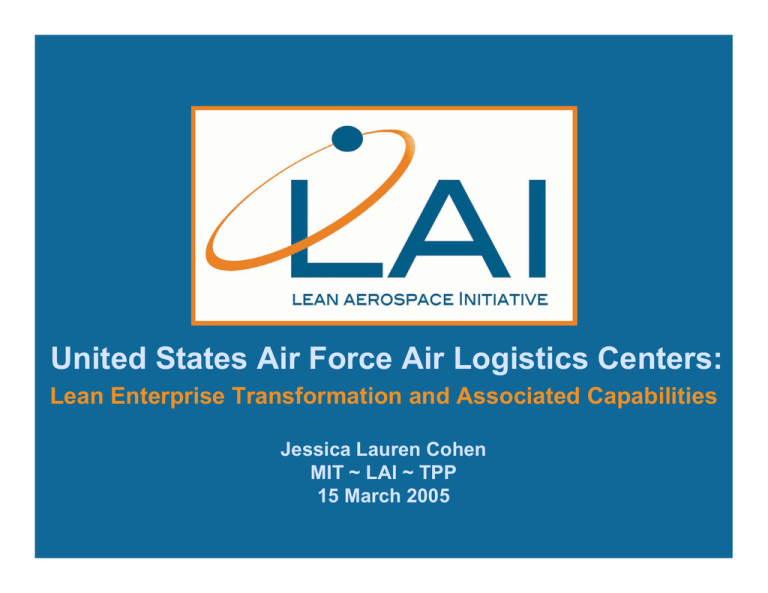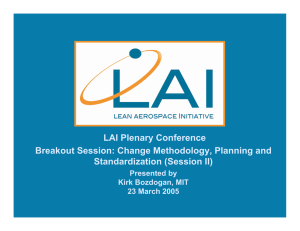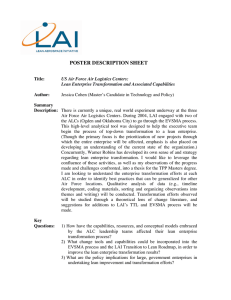United States Air Force Air Logistics Centers: Jessica Lauren Cohen
advertisement

United States Air Force Air Logistics Centers: Lean Enterprise Transformation and Associated Capabilities Jessica Lauren Cohen MIT ~ LAI ~ TPP 15 March 2005 Unique Opportunity for this Research • • • Three projects allowed for increased access for interviews and shop tours • Warner Robins case studies of the C-130, C-5, and Purchase Request lean efforts • Alpha-test of EVSMA with Ogden • Beta-test of EVSMA with Oklahoma City Looking to understand the enterprise transformation efforts at each ALC in order to identify best practices that can be generalized for other Air Force locations All comparisons will be done in light of previous LAI research and products, as well as organizational change literature web.mit.edu/lean © 2004 Massachusetts Institute of Technology Cohen/March 24,2004 - 2 Key Research Questions 1. How have the capabilities, resources, and conceptual models embraced by the ALC leadership teams affected their lean enterprise transformation process? 2. What change tools and capabilities could be incorporated into the EVSMA process and the LAI Transition to Lean Roadmap, in order to improve the lean enterprise transformation results? 3. What are the policy implications for large, government enterprises in undertaking lean improvement and transformation efforts? web.mit.edu/lean © 2004 Massachusetts Institute of Technology Cohen/March 24,2004 - 3 Presentation Overview • What is Lean Enterprise Transformation? • Air Logistics Centers and LAI • Research Methodology • Key Research Questions web.mit.edu/lean © 2004 Massachusetts Institute of Technology Cohen/March 24,2004 - 4 What is a Lean Enterprise? “A lean enterprise is an integrated entity that efficiently creates value for its multiple stakeholders by employing lean principles and practices.” – Lean Enterprise Value, Murman et al. web.mit.edu/lean © 2004 Massachusetts Institute of Technology Cohen/March 24,2004 - 5 web.mit.edu/lean © 2004 Massachusetts Institute of Technology Cohen/March 24,2004 - 6 Lean+Enterprise+Transformation • • • • Substantial, sustained, complementary change of Processes and Structures, Across organizations comprising a value stream, Shaped by organizations’ leaders, embraced by their employees and stakeholders, in response to organizational threats, and Adopting the Lean Interpretive Scheme of maximized value added, minimized waste, and employee learning and commitment. web.mit.edu/lean © 2004 Massachusetts Institute of Technology Cohen/March 24,2004 - 7 Enterprise Transition to Lean (TTL) Roadmap web.mit.edu/lean © 2004 Massachusetts Institute of Technology Cohen/March 24,2004 - 8 Enterprise Value Stream Mapping and Analysis (EVSMA) web.mit.edu/lean © 2004 Massachusetts Institute of Technology Cohen/March 24,2004 - 9 Presentation Overview • What is Lean Enterprise Transformation? • Air Logistics Centers and LAI • Research Methodology • Key Research Questions web.mit.edu/lean © 2004 Massachusetts Institute of Technology Cohen/March 24,2004 - 10 Air Logistics Centers • • • • • • The maintenance and repair organizations of the AF They are part of the Air Force Materiel Command There are three ALCs today Organized into four wings Each ALC has approximately 20,000 employees and conducts over $5 billion in business every year Transformation (at all levels) is imminent web.mit.edu/lean © 2004 Massachusetts Institute of Technology Cohen/March 24,2004 - 11 ALCs and LAI • • • • The LAI Enterprise Change Group was tasked by the LAI Executive Board to work more closely with the Air Force and study their transformation efforts The LAI Transition to Lean Roadmap is being applied to the ALCs Enterprise Value Stream Mapping and Analysis was developed by LAI as a way to begin the transformation process Current work provided access to all levels of the ALC web.mit.edu/lean © 2004 Massachusetts Institute of Technology Cohen/March 24,2004 - 12 Presentation Overview • What is Lean Enterprise Transformation? • Air Logistics Centers and LAI • Research Methodology • Key Research Questions web.mit.edu/lean © 2004 Massachusetts Institute of Technology Cohen/March 24,2004 - 13 Methodology • • • • • • Purchase Request case study of Warner Robins Observations of EVSMA engagement at Ogden and Oklahoma City Over 80 interviews conducted with individuals at all levels throughout each command Examination of transformation efforts observed through the theoretical lens of change literature Research questions were developed following observations and interviews (inductive study) Qualitative data analysis (timeline, coding materials, sorting and organizing into themes and writing) conducted web.mit.edu/lean © 2004 Massachusetts Institute of Technology Cohen/March 24,2004 - 14 Planned Change Model Why Change? Determining the need for change Determining the degree of choice about whether to change Defining the desired future state Describing the present state Getting from here to there: Assessing the present in terms of the future to determine the work to be done Managing during the transition state From Beckhard & Harris, Organizational Transitions, Addison-Wesley, 1987 web.mit.edu/lean © 2004 Massachusetts Institute of Technology Cohen/March 24,2004 - 15 web.mit.edu/lean © 2004 Massachusetts Institute of Technology Cohen/March 24,2004 - 16 Presentation Overview • What is Lean Enterprise Transformation? • Air Logistics Centers and LAI • Research Methodology • Key Research Questions web.mit.edu/lean © 2004 Massachusetts Institute of Technology Cohen/March 24,2004 - 17 Key Research Questions 1. How have the capabilities, resources, and conceptual models embraced by the ALC leadership teams affected their lean enterprise transformation process? 2. What change tools and capabilities could be incorporated into the EVSMA process and the LAI Transition to Lean Roadmap, in order to improve the lean enterprise transformation results? 3. What are the policy implications for large, government enterprises in undertaking lean improvement and transformation efforts? web.mit.edu/lean © 2004 Massachusetts Institute of Technology Cohen/March 24,2004 - 18 How have the capabilities, resources, and conceptual models embraced by the ALC leadership teams affected their lean enterprise transformation process? • • • • • • ALCs have not emphasized alignment of core processes and enterprise level activities ⇒ this leads to a stagnated transformation process Leadership personalities, and the lack of involvement, are affecting the willingness of employees to change “Middle Managers” are impeding change It is difficult to select the correct people to be change agents and work on lean projects ⇒ these roles must be clarified Consistent and just-in-time training is crucial for development of change capabilities Other change efforts are competing for resources web.mit.edu/lean © 2004 Massachusetts Institute of Technology Cohen/March 24,2004 - 19 What change tools and capabilities could be incorporated into the EVSMA process and the LAI Transition to Lean Roadmap, in order to improve the lean enterprise transformation results? • • • • • EVSMA creates a unique environment of regular and relatively informal meetings for leaders and change agents Enterprise level strategic planning is necessary, but not sufficient for successful transformation Development of capabilities that enhance bottom-up change (change agents, training for everyone, community of scientists, data driven work environment) should be considered up front and often Leadership mental models must be challenged Metrics (identification, baseline assessment, and continued measurement) and their importance must be stressed web.mit.edu/lean © 2004 Massachusetts Institute of Technology Cohen/March 24,2004 - 20 What are the policy implications for large, government enterprises in undertaking lean improvement and transformation efforts? • Federal fiscal policy establishes monuments that may remain un-moveable • There is no “profit motive” that we see in commercial endeavors • Advance requirements definition prohibits just-in-time inventory and • • development capabilities Congressional budgeting cycle negates “savings” and insists upon “cost avoidance” Human resources policy and employee mental models will likely conflict with lean enterprise transformation • Seniority requirements impede selection of preferred change agents • The tradition of rapid leadership turnover plus lifelong employment for civilian personnel leads to the “I can wait this out” attitude • In general, transformation will be more difficult, but not impossible, in this environment web.mit.edu/lean © 2004 Massachusetts Institute of Technology Cohen/March 24,2004 - 21 Any Questions? web.mit.edu/lean © 2004 Massachusetts Institute of Technology Cohen/March 24,2004 - 22





